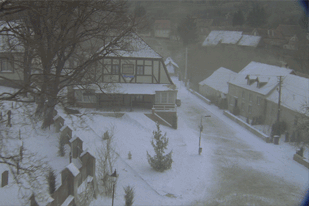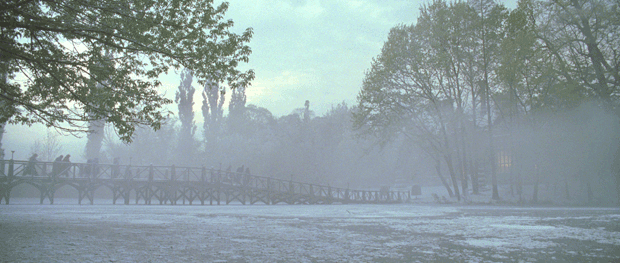Alain Bielik explores the vfx wizardry that went into the latest children's magical adventure, The Seeker: Dark is Rising.
After Harry Potter, The Chronicles of Narnia and Bridge to Terabithia, but before The Spiderwick Chronicles, here comes the latest entry in the ever popular new genre: a child's adventure into a magical world. In The Seeker: Dark is Rising (opening Oct. 5 from Fox/Walden), Will, a lonesome teenage boy, discovers that he has special powers, including the ability to travel through time. He soon finds out that there is a reason for him to have these powers, as he is to become a member of an ancient group of warriors fighting evil on Earth
Even though the movie relies on vfx in many sequences, the shot count ended up remarkably low. Overall Visual Effects Supervisor Jamie Price confirms, "We ended up with about 350 shots, including wire removals, which is not a lot by modern standards. I still split up the work among nine different vendors. Working with a fairly modest budget, we thought we could get a little extra value by taking advantage of the specialty and strengths of each individual vendor, as opposed to putting it all in one larger company and deal with the overhead that would bring"
Director David Cunningham, meanwhile, had a unique approach to the visual effects. Coming from a documentary background, he designed every scene as if it were part of a documentary. "He likes to cover scenes with multiple cameras," Price observes. "For one thing, it meant we couldn't use previsualization, except for a handful of tricky shots. Also, David never framed a shot in a way that would draw attention as a vfx shot. He made them all part of the fluid, organic action of a scene, which was great for us. The difficult aspect of this approach was that, with multiple camera angles, we would never know which take he was going to select until we had a first cut. It meant that we had to wait longer than usual to start working on the shots."

Rooks Into Water
Most of the visual effects were centered around the powers of the Rider, a character who is the manifestation of evil on Earth. One of these powers is the capacity to command a flock of supernatural rooks. Hydraulx was responsible for the majority of the rooks shots, including a spectacular scene where a huge flock explodes into a wall of water that floods a mansion. "We had a major shot where the camera flies at full speed along the crows toward the house," Price continues. "We filmed it undercranked with a 100-foot long cablecam rig that was running at 30 miles-per-hour The two exterior shots featured a water simulation, while the interior shot was created with a practical water effect combined with breakaway SFX glass."
For Hydraulx and in-house VFX Supervisor Erik Lyle, the transformation effect presented three distinct challenges. The first one was the transition itself, how, when and where it would happen. Once a concept was approved on paper, the team developed the effect on a single bird flapping "in place," using a Maya particle solution.
The second challenge was the issue of the velocity of the water once the transformation happened. Since these birds were flying quickly and rather violently, how did the water react to their movements? "Originally, the particles were very disconnected and strobing, even with motion blur," Lyle explains. "We had to adjust the transition to compensate for the erratic motion of the birds, as well as the distance covered in the short amount of time of the shot. By using a combination of particle expressions and fields, we were able to reign in the motion to something that looked right, as opposed to a physically accurate simulation."

Last was developing the look of the water. After looking at numerous reference images and movies, the team was able to break down the water into three distinct elements: a blobby surface, a foam pass emitted off the blobby surface, and a fine mist or spray element. All of these needed to integrate with each other, as well as with the CG birds that were in the scene, so the process of managing holdouts became a challenge in itself. "The particle count for a single bird was close to 500,000, so each bird needed to be simulated individually. Instead of rendering the water with refractions, we used custom mental ray shaders to output utility render passes for the Inferno compositors to control the look in the comp. With color correction and lensing, they were able to quickly dial in the look, and make simple changes to address client comments without re-rendering."
Rooks Into Snow
Meanwhile, at Mr. X, Visual Effects Supervisor Aaron Weintraub and his team were busy tackling an effect that was very similar in concept, but different in execution. This time, the script called for a transformation from rook to blizzard
The original plate was shot from a helicopter that flew over the main village set. "Once we received the plate, we matchmoved the camera, and undistorted the plate using boujou," recalls Weintraub. "Primitive geometry was built in Maya to represent the physical structures in the scene. To create the snowy landscape environment, we created matte paintings on a few representative frames of the plate using Photoshop. Using Nuke, elements of the matte paintings were projected onto the geometry, re-animated using the imported 3D camera, and integrated into the scene to give us a base plate of the snowy environment that we would transition to once the blizzard arrived.

"At the same time, animation was underway to have the flock of rooks emerge from underneath the bridge and eventually overtake the camera. Initial flap-cycle animation was done in Maya, baked out as a RIB archive, then referenced back into Maya to animate the flocking and flight paths. The birds were lit in Maya, and rendered with RenderMan. The timing of when each individual bird exploded into snow was also controlled within the master animation file."
Once the animation was locked, the data indicating the orientation of each bird on each frame, its position in the flap cycle, and whether it had exploded yet, was passed onto the effects animators. The team used this information, along with the RIB archived flap cycle, to regenerate the scene in Houdini to create the various particle effects that were required. The initial primitive scene geometry was also imported to create realistic interactions and collisions, as well as provide proper holdout mattes in the renders.
"There were three basic simulations running: the first was a general subtle snow trail that drifted naturally off the birds as they flew; the second was a more intense trailing of snow off their wings that came on right before each bird was about to explode, as though their wings began to transform first and were being eaten away; the third was the explosions themselves," Weintraub explains. "We used the mesh of each bird to source the particles, reparameterizing the geometry for even distribution, and filling up their volume. Once emitted, each particle had a number of forces acting upon it: the initial momentum from the flight of the bird, the wind of the building blizzard, and electrostatic charges that allowed the particles to both interact with each other and naturally disperse through the atmosphere. All the particles were rendered with RenderMan using a custom snow shader. Additional 2D and 3D elements, such as fog and snow, were also created for the shot. The elements were all combined using Nuke."

Twist and Shout
While rooks torment the heroes from the air, other perils manifest on the ground, including thousands of snakes in a key sequence assigned to Rising Sun Pictures. For shots featuring a handful of snakes, in-house VFX Supervisor Gregory Yepes and his team used traditional animation techniques through XSI and carried out the lighting through Maya using 3Delight. "As soon as we had to handle more than a couple of dozen snakes in a shot, we had to introduce a procedural crowd solution. For this, we used Maya particle effects to both build the snake poses as well as layout their animation paths. The snake poses were represented by very lightweight curves. Since we were dealing with so many snakes, it was prohibitive to even use low-resolution snake geometry for animation and rendering purposes.
"For the final rendering stage, we passed the snake curves into a 3Delight render procedural, which would skin each snake at render time. A 3Delight render procedural was used to define all the geometry necessary in a very small area of screen at a time. Our render procedural was also used to define and control which type of snake to place on each curve. This allowed our crowd effects to integrate with the various types of snakes already present on the set. Most shots ended up requiring a small percentage of hand animated snakes together with crowd snakes."

As Cold as CG Ice
Soon enough, the main characters find out that the Rider can also control non-living elements, such as icicles. Created by Rising Sun Pictures, the sequence involved populating the ceiling of a mansion with hundreds of icicles, and have them fall toward Will in a purposeful but realistic manner. "For the most part, icicle appearance was defined by refraction, reflection, specular, and most importantly, internal caustic properties," says Yepes. "In addition to the 3D icicle elements, many of the icicle sequence shots required additional mist and fog treatments using 2.5D techniques. In the most part, these were composited using either tracked cards from Maya or the 3D environment space available in Shake."
To create the caustic component of the icicles in an efficient manner, a number of 2D cheats were also employed. These ranged from combinations of numerous mattes and special lighting passes generated from 3D, to simply painting caustics where they were needed. A final layer of computer generated particles and volume smoke was added to help sell the movement and final integration of the icicles.
Facing Darkness
As if those weird events were not enough, the climax features evil's most bizarre and eerie manifestation: a wave of living darkness that swallows light itself. "The brief was very specific, but also very difficult to nail down visually," Price notes. "The wave had to look like a fluid without being smoke. It should feature a seemingly solid surface, but at the same time remain totally organic"
At Digital Domain, 49 shots were supervised by Kelly Port. "We did a lot of volumetric fluid simulations that we rendered with our proprietary volumetric render system Storm. The unique challenge of this assignment was to create a simulation with a real sense of purpose. On one hand, the cloud needed to look organic and had to flow according to the laws of physics; on the other hand, it needed to behave like a character, an aggressive and menacing character. It was not easy to find the right balance between the two aspects." The solution was to develop a two-layer animation. First, the team ran a fluid simulation to generate the dynamics of the wave, and then, attached the system to splines that were hand-animated. These tendril-shaped splines were specifically designed to emphasize the fact that this was a character, not a purely physical wave.
The first step was to model geometry corresponding to the live-action sets that the simulation had to interact with. Then, using Storm, which is built within the framework of Houdini, the team would run the fluid simulation. "It was basically made of ordered particles," Port explains. "From those particles, we would build a surface that we would render with Storm. Actually, when you look at the surface in 3D, it looks like a jumbled mess of points because they are all in different places, but once it is rendered out, it becomes this beautiful multi-layer surface. In order to get more flexibility in the composite, we split up the simulation in several layers, but we also systematically did a master pass in which everything was rendered together. This provided self-shadowing and interaction, which was especially important for the tendrils that were protruding from the wave. Using Nuke, compositors could then mix in part of that pass, while still keeping total control on the individual layers."
During the climax sequence, the cloud manages to grab Will and tries to swallow it. The effect was realized by animating tendrils to follow the movements of actor Alexander Ludwig being pulled up by wires on stage.

Magical and Miraculous
Throughout the movie, Will has to find magical signs that will allow him to defeat the powers of the Dark. Each time he touches one, the sign would glow from the energy inside and its pattern would come to life. Most of the animated signs were created with particle simulations by Riot, with RSP specifically handling the water sign effect.
"Among the vendors, I would also like to mention the small, but remarkable contributions of Illusion Arts and Rhythm & Hues," Price concludes. "They only did a couple of shots, but very difficult ones. R&H managed to dramatically age a character with 2D digital make-up. On their part, Illusion Arts was able to track a CG building behind hundreds of real tree branches. I knew it would be difficult, and their solution was amazing."
Alain Bielik is the founder and editor of renowned effects magazine S.F.X, published in France since 1991. He also contributes to various French publications, both print and online, and occasionally to Cinefex. In 2004, he organized a major special effects exhibition at the Musée International de la Miniature in Lyon, France.










